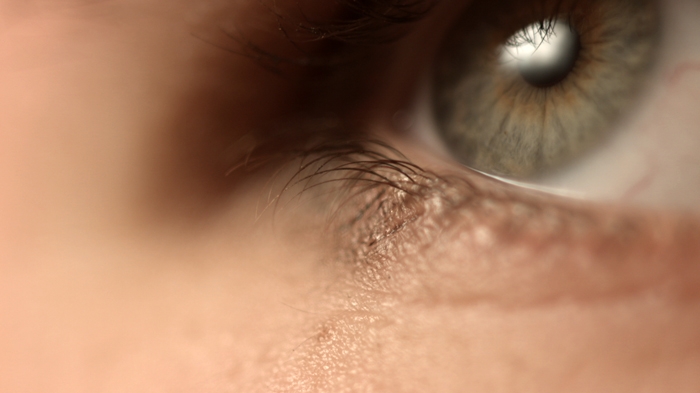Blood-tinged water sucked down the plughole, dissolving into a pearlescent eye framed by impeccable mascaraed eyelashes, but sightless. One of the most famous close-ups of an eye in cinema’s history, the shower scene from Hitchcock’s Psycho (1960) denotes death as a sudden rupture, a blank-staring, broken interface between the subjective body and the world. Taking this metaphor further, Ilona Sagar’s show Haptic Skins of a Glass Eye explores the awkward and sometimes perverse relationship between the contemporary body and its technological augmentations.
The core of the show is the title video, (2015), in which slick shots of bodies, eyes, glass-blowing, water-drops, hair and screens, all made alien yet vulnerable by the extensive use of intrusive close-ups, are accompanied by a voiceover speaking a disjointed text. At times introspective, at times calling out to an undisclosed interlocutor, it seems to allude to an internalised and somewhat schizoid meta-dialogue between tools and user.
The common thread is ‘glass delusion’, a psychic disorder recorded in Europe between the fifteenth and seventeenth centuries, under which people feared being made of glass and thus liable to be shattered. Its first appearance coincided with a newly discovered medium or ‘magic’ technology, the perfection of Cristallo glass, the first clear glass. Glass is the medium through which we commonly look at our surroundings – windows, screens, mirrors and optical devices, a tool for narcissism and self-analysis, a membrane between the inward and the outward. Modernist architecture adopted glass as the revealing material of its ideology of transparency, holding the promise of truth and progress.
Far from this promise, glass in Sagar’s video is deformed, incandescent, malleable, depicted in a state of becoming, as if life itself was being blown into its pulsating cavities – the work of master glass-blower Jochen Holz. His resulting glass sculptures, resembling long, feeble ligaments or taking the shape of two heart-like vessels knotted in an embrace, form part of an installation, along with an unassuming black-and-white paper scan of body parts and a hanging vinyl wallwork containing elements of a fragmented text. The exhibition’s performative element takes the form of two actors repeating a series of recorded interviews between the artist, psychiatrists and neuroscientists, as they hear them through headphones. These apparent dialogues touch themes like the connection between technological development, the expansion of body schema, and the construction of irrational beliefs as ways of gaining control over the unknowable; yet the opaque delivery interferes with the reassurance we might derive from these expert opinions.
The show, combining video, sculpture and performance under the threat of an obsolescent delusion, casts doubt on the transparency of our mediated, estranged, and potentially illusory experiences of the world. Sagar’s accomplished film-editing technique and skill in melding words, sound and imagery, allows her to condense extensive research into a vivid poetic translation of our symbiotic and enhancing yet murky and addictive relationship with technology. Despite avoiding ethical bias and futuristic forecasts, the show ultimately channels Sagar’s anxiousness; contrary to Janet Leigh’s unresponsive gaze in Psycho, the design of modern devices looks back at us, blending fingers, tears and optical fibres in a morphing of the physical, the psychological and the virtual.
Online exclusive published 3 December 2015
